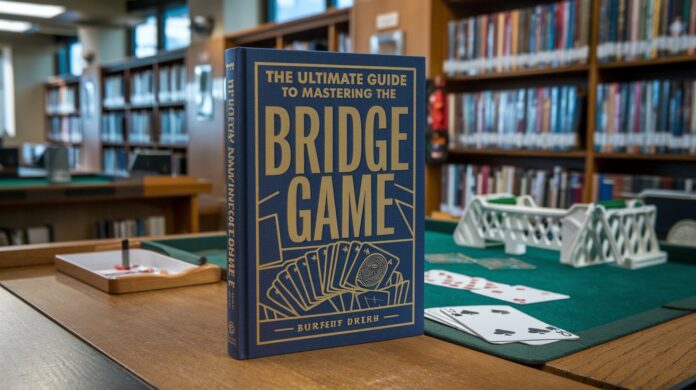Bridge is more than just a card game—it’s a battle of wits, strategy, and communication that has captivated players for centuries. Whether you’re a beginner curious about this intellectual pastime or an experienced player looking to refine your skills, this comprehensive guide to the bridge game will provide you with everything you need to know. From its history and rules to advanced strategies and tips for success, we’ll explore why bridge remains a timeless classic and how you can become a master of the game.
What is Bridge?
Bridge, specifically contract bridge, is a trick-taking card game played by four players in two partnerships. Unlike casual card games, bridge combines luck, skill, and teamwork, making it a favorite among strategic thinkers. The game is played with a standard 52-card deck, and the objective is to score points by winning tricks and fulfilling contracts based on bids made during the game.
Bridge is renowned for its depth and complexity, often compared to chess for its mental rigor. It’s a social game that fosters camaraderie, yet it’s fiercely competitive, with a global community of players participating in clubs, tournaments, and online platforms.
Why Play Bridge?
- Mental Stimulation: Bridge sharpens critical thinking, memory, and problem-solving skills. Studies suggest that playing bridge can even delay cognitive decline.
- Social Connection: Whether at a local club or online, bridge brings people together, fostering teamwork and communication.
- Global Appeal: From casual home games to international tournaments, bridge is played worldwide, offering endless opportunities to compete and connect.
- Endless Learning: No two bridge hands are ever the same, ensuring constant opportunities to learn and improve.
In this guide, we’ll break down the essentials of bridge, offer tips for beginners, and share advanced strategies to elevate your game.
The History of Bridge: A Timeless Classic
Bridge has a rich history that dates back to the 19th century. Its origins can be traced to whist, a popular trick-taking game in England. By the late 1800s, whist evolved into bridge-whist, which introduced the concept of a trump suit. In the 1920s, contract bridge emerged, thanks to American innovator Harold Vanderbilt, who refined the scoring system and bidding rules.
Since then, contract bridge has become the dominant form of the game, with standardized rules established by organizations like the American Contract Bridge League (ACBL) and the World Bridge Federation (WBF). Today, bridge is played in homes, clubs, and online platforms, with millions of enthusiasts worldwide.
How to Play Bridge: The Basics
To master bridge, you need to understand its core components: the deck, the players, the bidding, and the play. Here’s a beginner-friendly overview of how the game works.
1. The Setup
- Players: Four players form two partnerships (North-South and East-West).
- Deck: A standard 52-card deck is used, with cards ranked from Ace (highest) to 2 (lowest).
- Deal: The dealer distributes 13 cards to each player, one at a time, clockwise.
2. The Bidding Phase
Bidding is the heart of bridge, where players communicate with their partners to determine the contract—the number of tricks their partnership aims to win and the trump suit (or no-trump). Bids are made in a clockwise order, with each bid consisting of a number (1 to 7) and a suit (clubs, diamonds, hearts, spades, or no-trump).
- Example: A bid of “2 Hearts” means the partnership aims to win at least 8 tricks (6 + 2) with hearts as the trump suit.
- Pass: Players can pass if they don’t want to bid.
- Double/Redouble: Special calls that increase the stakes of the contract.
The bidding continues until three consecutive players pass. The final bid becomes the contract, and the partnership that made it must try to fulfill it.
3. The Play Phase
The play begins with the declarer (the player who first bid the suit of the final contract) attempting to win the contracted number of tricks. Their partner, the dummy, lays their cards face-up on the table, and the declarer plays both hands.
- Tricks: Each player plays one card per trick, following the suit led if possible. The highest card in the led suit or the highest trump card wins the trick.
- Trump Suit: If a trump suit was chosen, any card in that suit beats cards of other suits, regardless of rank.
4. Scoring
Points are awarded based on whether the partnership fulfills or exceeds the contract. Bonus points are given for slams (winning 12 or 13 tricks) or for defeating the opponents’ contract. Scoring can be complex, but beginners can rely on score sheets or apps to track points.
Bridge Bidding Systems: Your Roadmap to Success
Bidding is where bridge’s complexity shines. A good bidding system allows partners to exchange information about their hands without explicitly stating it (which is against the rules). Here are some popular bidding systems for beginners and advanced players:
1. Standard American Bidding
This is the most widely used system for beginners in North America. It emphasizes natural bids, where players bid suits they have strength in.
- Opening Bids: Typically start with a strong suit (e.g., 1 Heart for a hand with 12+ high-card points and at least five hearts).
- Responses: Partners respond to indicate support or suggest alternative suits.
2. Precision Bidding
A more advanced system, Precision is highly structured and uses artificial bids to convey specific hand strengths. It’s popular among competitive players for its accuracy.
3. Acol Bidding
Common in the UK, Acol is a natural bidding system that emphasizes four-card suits and flexible bidding.
Strategies to Improve Your Bridge Game
Bridge is a game of skill, and even small improvements in strategy can make a big difference. Here are some tips to elevate your game, whether you’re a novice or a seasoned player.
For Beginners
- Learn the Point System: Use the High Card Point (HCP) system to evaluate your hand:
- Ace = 4 points
- King = 3 points
- Queen = 2 points
- Jack = 1 point
A strong opening bid typically requires 12+ HCP.
- Communicate with Your Partner: Bidding is a conversation. Use your bids to tell your partner about your hand’s strength and suit length.
- Practice Counting Tricks: Estimate how many tricks you can win based on your high cards and suit length.
- Start with No-Trump: No-trump contracts are simpler for beginners, as they don’t involve a trump suit.
- Join a Club or Online Platform: Playing regularly with others accelerates learning. Platforms like Bridge Base Online (BBO) offer free games and tutorials.
For Intermediate Players
- Master Conventions: Learn common bidding conventions like Stayman (to find a 4-4 major suit fit) and Blackwood (to ask for aces in slam bidding).
- Pay Attention to Opponents’ Bids: Their bids reveal information about their hands, which can guide your strategy.
- Plan the Play: As declarer, plan your approach before playing the first card. Consider how to use the dummy’s cards effectively.
- Defensive Play: When defending, signal to your partner using high-low card plays to indicate suit strength or length.
For Advanced Players
- Develop a Partnership Agreement: Work with your partner to agree on a bidding system and conventions to ensure seamless communication.
- Count the Deck: Track which cards have been played to deduce what’s left in opponents’ hands.
- Use Finesses Wisely: A finesse is a technique to win a trick with a lower card by trapping an opponent’s higher card. Practice common finesses to maximize tricks.
- Bid Aggressively for Slams: Recognize hands with slam potential (12 or 13 tricks) and use conventions like Blackwood or Gerber to confirm key cards.
Common Mistakes to Avoid in Bridge
Even experienced players make mistakes. Here are some pitfalls to watch out for:
- Overbidding: Bidding too high without enough strength can lead to penalties.
- Ignoring Partner’s Signals: Pay attention to your partner’s bids and card plays to avoid miscommunication.
- Poor Card Management: Don’t waste high cards early in the game; save them for critical tricks.
- Forgetting the Opponents: Always consider what the opponents might hold based on their bids and plays.
Bridge Communities and Resources
Bridge is a social game, and joining a community can enhance your experience. Here are some ways to connect and learn:
- Local Bridge Clubs: Check with the ACBL or WBF for clubs near you. Many offer beginner lessons and casual games.
- Online Platforms: Websites like Bridge Base Online, Funbridge, and OKbridge allow you to play against real opponents or bots.
- Books and Tutorials: Classics like “Bridge for Dummies” by Eddie Kantar or “The Official ACBL Encyclopedia of Bridge” are great for learning.
- Tournaments: Participate in local or online tournaments to test your skills and meet other players.
Bridge in the Digital Age
The rise of online platforms has made bridge more accessible than ever. Apps and websites offer tutorials, practice hands, and competitive play. Many platforms also provide AI opponents, allowing you to practice anytime. Online bridge has also fostered a global community, with players from different countries competing in virtual tournaments.
Why Bridge is Worth Learning
Bridge is a game that rewards dedication and practice. Its blend of strategy, teamwork, and intellectual challenge makes it uniquely satisfying. Whether you play for fun, social connection, or competition, bridge offers something for everyone. Plus, its mental benefits and global popularity ensure it’s a skill worth mastering.
Conclusion: Your Bridge Adventure Awaits
Bridge is a game of endless possibilities, where every hand presents a new puzzle to solve. By understanding the rules, practicing regularly, and embracing the strategic depth of the game, you can go from a novice to a confident player. Whether you’re playing at a kitchen table, a local club, or an online platform, bridge offers a rewarding experience that sharpens your mind and connects you with others.
Ready to start your bridge journey? Grab a deck of cards, find a partner, and dive into the fascinating world of bridge. With practice and patience, you’ll soon be bidding and winning tricks like a pro!

Zareb Saleh is a journalist at Gulf Today and a ghostwriter for Gameoholic, specializing in gaming, technology, and digital culture. With a keen eye for industry trends, he delivers insightful stories that engage and inform readers.




